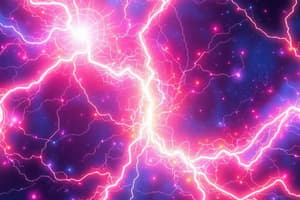Podcast
Questions and Answers
विद्युत प्रतिरोध की इकाई क्या है?
विद्युत प्रतिरोध की इकाई क्या है?
- एम्पियर (A)
- ओम (Ω) (correct)
- वोल्ट (V)
- कूलम्ब (C)
विद्युत धारा की दिशा क्या है?
विद्युत धारा की दिशा क्या है?
- चार्ज के प्रवाह की विपरीत दिशा
- समता में चार्ज के प्रवाह की दिशा
- ऋणात्मक चार्ज के प्रवाह की दिशा
- धनात्मक चार्ज के प्रवाह की दिशा (correct)
विद्युत ऊर्जा की इकाई क्या है?
विद्युत ऊर्जा की इकाई क्या है?
- वोल्ट (V)
- जूल (J) (correct)
- कूलम्ब (C)
- एम्पियर (A)
विद्युत शक्ति का सूत्र क्या है?
विद्युत शक्ति का सूत्र क्या है?
विद्युत परिपथ के प्रकारों की संख्या क्या है?
विद्युत परिपथ के प्रकारों की संख्या क्या है?
विद्युत विभवान्तर की इकाई क्या है?
विद्युत विभवान्तर की इकाई क्या है?
विद्युत धारा की परिभाषा क्या है?
विद्युत धारा की परिभाषा क्या है?
ओम का नियम क्या है?
ओम का नियम क्या है?
Flashcards are hidden until you start studying
Study Notes
Electricity
Electric Charge
- Electric charge is a fundamental property of matter
- There are two types of electric charges: positive and negative
- Like charges repel each other, while opposite charges attract each other
- Electric charge is measured in coulombs (C)
Electric Current
- Electric current is the flow of electric charge
- It is measured in amperes (A)
- Current is defined as the rate of flow of charge: I = ΔQ / Δt
- The direction of current is the direction of flow of positive charge
Electric Potential Difference (Voltage)
- Electric potential difference, or voltage, is the potential energy per unit charge
- It is measured in volts (V)
- Voltage is the driving force behind electric current
- It is defined as the work done per unit charge in moving a charge from one point to another: V = W / Q
Resistance
- Resistance is the opposition to the flow of electric current
- It is measured in ohms (Ω)
- Resistance depends on the material, length, and cross-sectional area of a conductor
- Ohm's Law states that voltage is proportional to current and inversely proportional to resistance: V = I × R
Circuits
- A circuit is a closed path through which electric current flows
- There are two types of circuits: series and parallel
- In a series circuit, the current is the same throughout the circuit
- In a parallel circuit, the voltage is the same throughout the circuit
Electric Power
- Electric power is the rate at which electric energy is transferred
- It is measured in watts (W)
- Power is the product of voltage and current: P = V × I
Electric Energy
- Electric energy is the total energy transferred in a circuit
- It is measured in joules (J)
- Energy is the product of power and time: E = P × t
विद्युत
विद्युत आवेश
- पदार्थ का मूल गुण विद्युत आवेश है
- विद्युत आवेश दो प्रकार के होते हैं: धन आवेश और ऋण आवेश
- समान आवेश एक दूसरे को प्रतिकर्ष करते हैं, जबकि विपरीत आवेश एक दूसरे को आकर्षित करते हैं
- विद्युत आवेश कूलॉम (C) में मापा जाता है
विद्युत धारा
- विद्युत धारा विद्युत आवेश का प्रवाह है
- यह एंपियर (A) में मापा जाता है
- धारा की परिभाषा आवेश के प्रवाह की दर है: I = ΔQ / Δt
- धन आवेश के प्रवाह की दिशा में ही धारा की दिशा होती है
विद्युत संभावान्तर (वोल्टेज)
- विद्युत संभावान्तर या वोल्टेज, प्रति आवेश की संभावित ऊर्जा है
- यह वोल्ट (V) में मापा जाता है
- वोल्टेज विद्युत धारा के पीछे की प्रेरक शक्ति है
- यह एक बिंदु से दूसरे बिंदु तक एक आवेश को ले जाने में किया गया कार्य प्रति आवेश है: V = W / Q
प्रतिरोध
- प्रतिरोध विद्युत धारा का प्रतिरोध है
- यह ओह्म (Ω) में मापा जाता है
- प्रतिरोध संवाहक के पदार्थ, लंबाई और पार्श्व क्षेत्रफल पर निर्भर करता है
- ओह्म का नियम बताता है कि वोल्टेज धारा के समानुपाती और प्रतिरोध के व्युत्क्रमानुपाती है: V = I × R
परिपथ
- परिपथ वह बंद पथ है जिसके माध्यम से विद्युत धारा प्रवाहित होती है
- दो प्रकार के परिपथ हैं: श्रेणी और समानांतर
- श्रेणी परिपथ में पूरे परिपथ में एक ही धारा होती है
- समानांतर परिपथ में पूरे परिपथ में एक ही वोल्टेज होता है
विद्युत शक्ति
- विद्युत शक्ति विद्युत ऊर्जा का स्थानांतरण दर है
- यह वाट (W) में मापा जाता है
- शक्ति वोल्टेज और धारा का गुणनफल है: P = V × I
विद्युत ऊर्जा
- विद्युत ऊर्जा परिपथ में स्थानांतरित कुल ऊर्जा है
- यह जूल (J) में मापा जाता है
- ऊर्जा शक्ति और समय का गुणनफल है: E = P × t
Studying That Suits You
Use AI to generate personalized quizzes and flashcards to suit your learning preferences.




